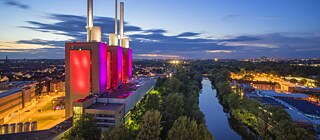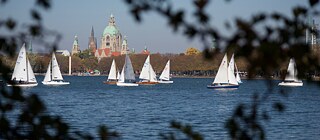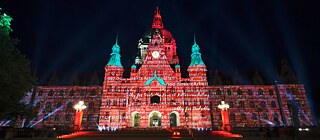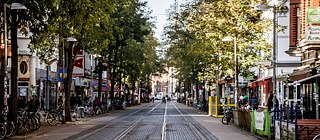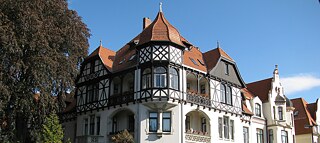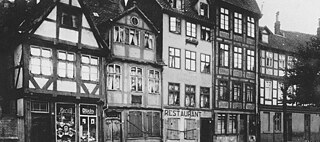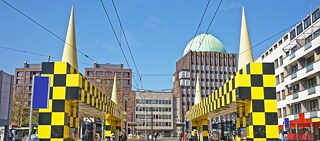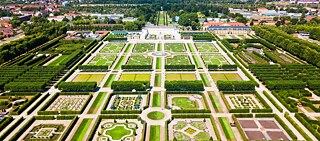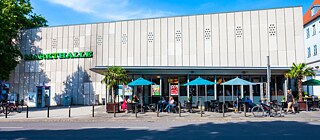Boring? Colourless? Despite what you may have heard, Hannover is none of these things; it’s just as exciting as Berlin or Hamburg – only more manageable and without all the irritations. Time for a visit to what is probably the most underrated city in the world.
By Nadine Conti
High life und true crime
Maschsee is located in the middle of the city and offers plenty of entertainment. | Photo (detail): © Adobe
According to biology, water is the source of all life. In Hannover too, all life is drawn to the water sooner or later. More precisely: to Maschsee. Smack dab in the middle of the city, the lake has had an eventful history and – if you do it right – is the perfect place to while away a few pleasant hours: jogging or walking, inline skating or boating. Hannover 96’s football stadium, the Gilde Park Stage for open-air concerts, the Lower Saxony State Museum, the Sprengel Museum of Modern Art, and NDR’s broadcasting studios are also close to the lake. For three weeks in summer, usually from the end of July to the beginning of August, the lakeshore and its residents go into a state of emergency: Maschsee Lake Festival features music and cabaret on several stages and plenty of food and drink. Every year, around two million visitors from the surrounding area come to partake. And the eventful history? The artificial lake was dug in the 1930s as a job creation measure – a showpiece of the Nazis, although the plans were considerably older. As the inscription on the pillar holding the torchbearer still proclaims: “The will to build gave labour-loving hands the blessing of work – henceforth the lake will also provide joy, health and strength. 1934-1936.” And here too was where a passer-by discovered parts of a woman’s body in the water in 2012 –neo-Nazi rapper and TV extra Alexander K., aka Sash SM, was later convicted and can now also add “Maschsee Murderer” to his list of aliases.
An oblique trip
A beautiful sight by day and by night: the New Town Hall. | Photo (detail): ©picture alliance/Geisler-Fotopress/Ulrich Stamm
Almost every city has an outlook that is the idea destination for a Sunday stroll to see the city spread out at your feet – and for a selfie against a good panorama. In Hannover, this is the dome in the Neue Rathaus or New Town Hall. Getting there is much more than half the fun: a parabolic lift rumbles stunningly and dizzyingly through the old timberwork, clearly visible through the glass ceiling and floor. Unfortunately, rides have temporarily been halted during the coronavirus pandemic, as there is no way to keep a safe distance on board. This is especially unfortunate since there is no other way to get up to the dome. So hopeful visitors will have to wait for the end of the pandemic. Apart from that, the Rathaus itself, the square in front of it, Trammplatz, and Maschpark behind it are all also more than worth a look.
Always a bit different
In 1995, the clashes between punks and the police went down in the history books as the “Chaostage Hannover”. Today, things are calmer in the Nordstadt district. | Photo (detail): ©picture-alliance/dpa/Hollemann
Does anyone still remember the legendary Chaostage or Chaos Days in the mid-1990s, when punks and left-wingers fought street battles with the police that lasted for hours? Yup, that happened here. At the time, the fights were essentially initiated by the occupants of the Sprengel site, an old chocolate factory in the Nordstadt district that was closed in 1980 and occupied by squatters as early as 1987 – and has undergone a number of metamorphoses since. The area has calmed down a lot in the meantime, but one thing still unites the residents: a longing for alternative ways of life beyond the philistine bourgeoisie. Now a residential project with its own infrastructure – a workshop, a Volxküche or co-op soup kitchen, pub, cinema, and childcare centre – the Sprengel site has become a focal point for everything a bit left of centre, alternative, and queer. In this it is not alone in the district, of course. Nordstadt behind the university is still diverse, filled with students and migrants – even if the owners of expensively renovated flats in historic buildings are increasingly causing new conflicts of use. The “E-Damm”, short for Engelbosteler Damm, is the main artery. Especially on warm summer nights, the square around the Lutheran Church is “the place to be”. A walk through the quarter is worthwhile at any time of the year or day though: There is always something new to discover in the lively, changing cast of cafés, pubs and shops.
Where the action is
The Linden district: Here hanging out on the corner with mates is known as “limmern”. | Photo (detail): © Adobe
When you talk about Nordstadt, Linden is bound to come up sooner or later. For decades, the two districts have competed for the title of “hippest part of the city”. For some locals, the answer is practically a religious conviction, but it doesn’t really matter if you’re visiting: There is fun to be had in both parts of town, which are actually fairly close together. What young people in Hamburg call “corner”, basically standing around on a street corner with friends and alcoholic drinks from the kiosk, is “limmern” here: Limmerstraße is the jumping off point for party lovers and runs through North Linden. This doesn’t mean you have to stand around sipping your drink – there are plenty of pubs to the right and the left. Limmerstraße starts at the Küchengarten where tango dancers like to cut up with the party people and skaters. The Ihme Centre next door is worth checking out for other reasons: It is one of those ruthless construction crimes committed in the 1960s and today adds an interestingly creepy vibe as a mix of abandoned space, giant construction site and crime scene backdrop. It was once planned as a “city in the city” with offices, flats, shops and a cultural centre all in one – but to this day, a revolving door of investors have all failed in their attempts to revive the giant arial. If that’s too dreary for you, check out the events calendar for “Faust,” “Glocksee” or “Capitol” – all venues within walking distance from here.
Chirpy and colourful
Niki de Saint Phalle’s Nanas on the banks of the Leine River. | Photo (detail): © picture alliance/Bildagentur-online/Schoening
When the round and colourful Nanas, three larger-than-life pop art sculptures by French-Swiss artist Niki de Saint Phalle, took up residence on the banks of the Leine River in 1974, the Hanoverian bourgeoisie was turned upside down. They took so much plump femininity as a shameless afront – no way could this be art! In the intervening years, their creator has become an honorary citizen of the city. Niki de Saint Phalle designed the grotto in the Herrenhäuser Gardens, bequeathed her estate to the Sprengel Museum, and the shopping arcade between Kröpcke Square and Central Station was named in her honour. The large, colourful polyester figures on the banks of the Leine are now one of the city’s landmarks and a favourite photo op. On Saturday mornings, things get pretty busy around the Nanas when the popular – and, due to the location on the riverbank, very picturesque – flea market takes place here. The riverbank of the Leine has gotten a serious upgrade in recent years; new buildings and restaurants will hopefully bring more life to the area and encourage visitors to the historic museum, Begin Tower and the city gate to stay a little longer. Soon it will be richer by one more attraction when the standing wave for surfers is finished near the Leine Dam at the Landtag or state parliament.
Hanover’s villa district
Idyllic and centrally located: the Waldhausen villa district. | © GeorgDerReisende/CC BY-SA 4.0
Hanoverians are notorious for keeping things low key – which might have something to do with their historical proximity to the English royal family. Or maybe it is partly because the city’s most expensive residential area, the Waldhausen villa district, puts on a modest face and is hardly visible beneath the tree canopy from the vantage point atop the town hall. It is both idyllic and centrally located between the Maschsee, Engesohde Cemetery and Eilenriede Forest, is also hemmed in by two railroad lines and absolutely worth a walk through. Especially Güntherstraße lined by lovingly restored Art Nouveau and Wilhelminian style facades. You might get lucky and spot a celebrity, although the glamour factor is in keeping with the typical Hanoverian understatement: The quarter’s best-known residents are former German Chancellor Gerhard Schröder and former German President Christian Wulff.
The hatchet man
This was the scene of at least 24 murders: the home of Fritz Haarmann, who was executed for his crimes in 1925. | Photo (detail): © picture-alliance/dpa/dpa Polizeigeschichtliche Sammlung
London has Jack the Ripper, Hanover has Haarmann: “Wait, wait, just a little while. Soon Haarmann will come to you too and make mincemeat out of you with his hatchet,” go the lyrics to a mocking song from the beginning of the last century when he terrorising the city. The story of serial killer and rapist Friedrich “Fritz” Haarmann has fascinated people for a hundred years now. Writers, musicians and filmmakers have explored his story, he has long been part of Hanover’s folklore and is even included on Advent calendars. Not much is left of the places where he lived and did his evil deeds: today’s Rote Reihe in Calenberg Neustadt has nothing in common with the narrow, shabby old town alley where Haarmann lived, killed and hawked his victims’ clothes. The café on Kröpcke Square is still around but is nothing like the dubious dive at the heart of the gay (and still highly illegal, of course) street prostitution scene back then. And the train station, where Haarmann and his accomplices lurked in the heated waiting room to pick up poor boys from the countryside, stranded, unemployed men, and runaways from care homes – has long since been converted into a modern, light-flooded “shopping station”. There is still a large memorial stone for the 24 boys and men we are relatively certain he lured into his flat, then raped, killed and dismembered. Rumours persist that there were many more and that Haarmann even processed and sold their flesh. The trial attracted international attention and kicked off a police scandal. The court prison where Haarmann was finally executed is also gone. The old “königliche Zellengefängnis” prison directly behind the central train station was demolished in 1963. Today, Raschplatz, a pedestrian square, and alternative event centre Pavillon have taken its place. In 2017, an app was developed there in workshops, the free “Pavillon Prison Break” game you can use to take off on a little journey through time on site.
Legos for giants
Who left their Legos here? This is what bus stops look like when architects get particularly creative, like Alessandro Mendini in this case. | Photo (detail): © Adobe
The Steintor underground stop on the edge of the pedestrian zone in the middle of the city is a good starting point for expeditions – to architectural highlights, the red-light and party district, or for an extensive shopping trip. Architecture first: The 51-metre-tall Anzeiger-Hochhaus, the brick building with the green dome on top, was one of the first high-rises in Germany. Built in 1928, its steel skeleton even survived the nights of bombing to go on to make press history after the war: Both news magazines “Der Spiegel” and “Stern” were founded here where today the RTL and Sat.1 TV broadcasters have their regional editorial offices along with departments from the regional radio stations ffn and Antenne Niedersachsen. Diagonally across the street is the beautiful neo-baroque façade of the Tiedthof, formerly the entrance to the Gewerkschaftsviertel or Union district. Also very interesting: the unusual, black-and-yellow checkerboard patterned cuboids topped by little golden hats that serve as bus stops on Kurt Schuhmacher Straße. They were designed by star Italian architect Alessandro Mendini, who was also responsible for the strikingly colourful facade that shimmers a little further on at the corner of Lange Laube and Stiftstraße and looks as if giants had played around with Legos. Gehry Tower twines its way into the sky bit further down on Goethestraße. Walking into the side streets behind this twisted corner is like entering into another world. This is the red-light district, which notorious Hells Angels boss Frank Hanebuth successfully transformed into a kind of Hanoverian Reeperbahn starting in the 2000s – with hip clubs bordered by strip joints, brothels and gambling dens. The party mood has let up a bit since, and there are plans to bring in expensive downtown flats instead. And if it’s much too early to party anyway, then it’s just the time for a little shopping spree: Either in the pedestrian zone, which extends over several streets, or in the Ernst August Galerie, Hannover’s largest mall, on Kurt Schuhmacher Straße.
Each garden is unique
What a sight! The Herrenhäuser Gardens from above. | Photo (detail): © Adobe
If you’re ever in Hannover, a visit to the Herrenhäuser Gardens is a must. But the Gardens, as the taciturn Hanoverians call them, are actually three different worlds. First, there’s the Berggarten complete with sea life, a skilled combination of botanical education plus family entertainment if you will. If you enjoy marvelling at exotic plant and animal species and walking back out feeling proud to have learned something new, this is the place for you. Then there’s the upscale entertainment area: the Große Garten, with its baroque splendour, is not just a historical gem, but also a sensual delight. Walk through the playful grotto designed by Niki de Saint Phalle – the artist who created the Nanas on the banks of the Leine – a small maze and an enchanting theatre complex. The events schedule is certainly worth a look: there are plenty of festivities, concerts, theatre performances and fireworks competitions. Finally, the Georgengarten (an English landscape garden) and the Welfengarten (Guelph Garden) behind the castle that houses the university shine with fewer artificial shapes, but offer picture-perfect landscapes and lots of life. If you haven’t already, this is the moment to loosen your collar and throw off your shoes: People meet up here to study, chill and picnic. There is always the faint sound of drumming from somewhere, the smell of barbecue on the summer air, and a chance unwind from everyday life.
Markthalle – in the belly of the city
The Market Hall. Not particularly spectacular, yet still a popular place to go at all times of day and night. | Photo (detail): © Adobe
The Markthalle at the outskirts of the historical town centre is an all-around talent. Over the day it offers breakfasts to cure a hangover and a place for lobbyists and journalists to meet with politicians or their staff (the state parliament and most ministries are not far away). In the evening, people come to enjoy an after-work beer or a snack before heading home or heading out into the night. The selection isn’t terribly original (a bit of Italian here, a little Asian there, something with meat, fish, or bread in between), but at least you can find vegan food now, so there’s something for everyone. And grab something delicious to go, that is if you haven’t forgotten by the third glass of wine.
How do you like Germany #NoFilter?
Help us to improve our magazine and take our survey! Thank you!
>> To the survey
